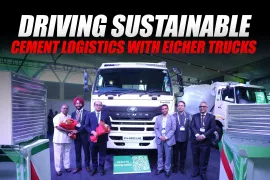India’s commercial vehicle industry faces a complex challenge today. The sector supports cleaner mobility, yet it asks for emission rules that match real operating conditions. Manufacturers now speak in one voice and their demand is simple: build regulations that recognise how commercial vehicles actually run on Indian roads.
The gap between regulation and reality has widened over time. Test cycles designed for passenger vehicles still shape many of India’s fuel-efficiency and emission norms. These cycles assume steady speeds, controlled loads and predictable terrain. Heavy-duty trucks and buses, however, rarely experience such conditions. They climb steep gradients, carry shifting loads, idle for long stretches and move through heat, dust and inconsistent traffic. When rules ignore these variables, the testing system breaks and the results lose meaning.
This concern came into sharp focus during Tata Motors’ recent financial briefing. The company’s leadership explained how the entire industry has taken a unified stand on the proposed CAFE norms. Here, Tata Motors confirmed that the industry has collectively sought a pragmatic exemption. Their reasoning was clear: unrealistic testing parameters create compliance pressure without producing proportionate environmental benefits.

SIAM has already submitted detailed recommendations to the Bureau of Energy Efficiency and the Ministry of Road Transport & Highways. These recommendations ask regulators to move away from constant-speed fuel consumption metrics. Instead, SIAM proposes the Vehicle Energy Consumption Tool, often called the Bharat Vector Tool. This tool models real-world duty cycles. It incorporates terrain changes, load variations, start-stop patterns and gradient challenges. Because the tool captures how medium and heavy commercial vehicles truly perform, manufacturers believe it offers a more accurate and fair basis for future norms.
Another area of strong industry consensus pertains to the N1 light commercial vehicle category. Data demonstrated that the N1 vehicle segment accounted for less than 1% of the total CO₂ emissions from the sector. Manufacturers presented the case that putting the N1 segment in a position where more stringent future fuel-efficiency norms would apply may increase the burden on smaller operators without producing any identifiable environmental benefits. They were asking for an exemption based on the low impact of the segment.
Concerns also arise around the upcoming Bharat Stage regulations. New after-treatment systems require long approval timelines for their proof of performance. Infrastructure must also accelerate in development and roll out to match technology development. Fuel quality also must be homogeneous across the country. And when things happen too quickly (think how quickly the transition was from BS4 to BS6), the whole ecosystem feels the impact. Manufacturers invest, transporters pay more for up time and service networks adapt to the changing landscape. That said, a timeline that is progressive and predictable, the sector argues, can prove beneficial for both environmental and economic paradigms.
The sector's position does not show similar progress, instead it insists on realism. Cleaner norms are good, but the road to that point must be technically feasible, economically rational and operationally practical. And as long as testing appears representative of the actual use and the timelines are steady, then the shift to cleaner transports is less likely to disrupt people's lives in India in moving towards sustainable forms of transportation.
For more articles and news, stay updated with 91trucks. Subscribe to our YouTube channel and follow us on Facebook, Instagram and LinkedIn for the latest videos and updates from the automotive world.
Web Stories
Latest Industry Insights News
Categories
91trucks is a rapidly growing digital platform that offers the latest updates and comprehensive information about the commercial vehicle industry.









